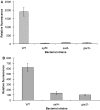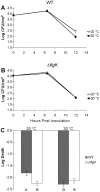Thermo-regulation of genes mediating motility and plant interactions in Pseudomonas syringae
- PMID: 23527276
- PMCID: PMC3602303
- DOI: 10.1371/journal.pone.0059850
Thermo-regulation of genes mediating motility and plant interactions in Pseudomonas syringae
Abstract
Pseudomonas syringae is an important phyllosphere colonist that utilizes flagellum-mediated motility both as a means to explore leaf surfaces, as well as to invade into leaf interiors, where it survives as a pathogen. We found that multiple forms of flagellum-mediated motility are thermo-suppressed, including swarming and swimming motility. Suppression of swarming motility occurs between 28° and 30 °C, which coincides with the optimal growth temperature of P. syringae. Both fliC (encoding flagellin) and syfA (encoding a non-ribosomal peptide synthetase involved in syringafactin biosynthesis) were suppressed with increasing temperature. RNA-seq revealed 1440 genes of the P. syringae genome are temperature sensitive in expression. Genes involved in polysaccharide synthesis and regulation, phage and IS elements, type VI secretion, chemosensing and chemotaxis, translation, flagellar synthesis and motility, and phytotoxin synthesis and transport were generally repressed at 30 °C, while genes involved in transcriptional regulation, quaternary ammonium compound metabolism and transport, chaperone/heat shock proteins, and hypothetical genes were generally induced at 30 °C. Deletion of flgM, a key regulator in the transition from class III to class IV gene expression, led to elevated and constitutive expression of fliC regardless of temperature, but did not affect thermo-regulation of syfA. This work highlights the importance of temperature in the biology of P. syringae, as many genes encoding traits important for plant-microbe interactions were thermo-regulated.
Conflict of interest statement
Figures






References
-
- Rouse DI, Nordheim EV, Hirano SS, Upper CD (1985) A Model relating the probability of foliar disease incidence to the population frequencies of bacterial plant-pathogens. Phytopathology 75: 505–509.
-
- Schonherr J (2006) Characterization of aqueous pores in plant cuticles and permeation of ionic solutes. J Exp Bot 57: 2471–2491. - PubMed
Publication types
MeSH terms
Substances
LinkOut - more resources
Full Text Sources
Other Literature Sources

